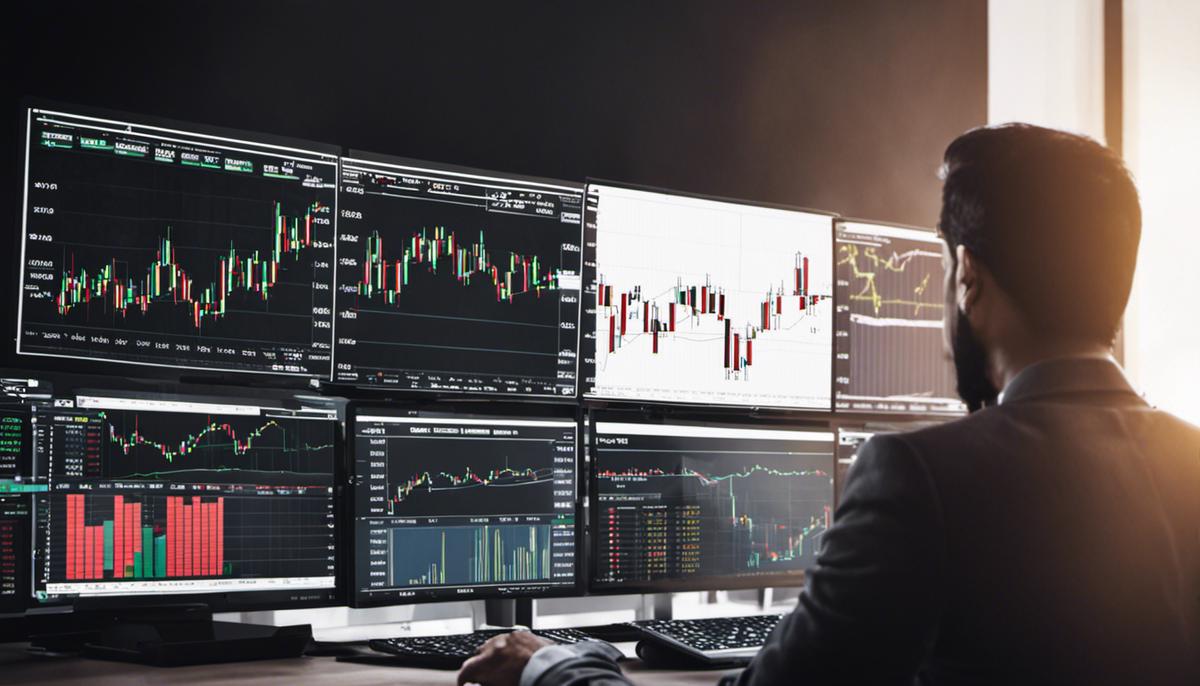Forex Trading: A Beginners’ Guide
Delving into the world of Forex trading can seem like a daunting task for beginners. With new concepts, language, and mechanisms, it’s easy to feel overwhelmed. Fear not, this document dives deep into the realm of Forex trading, digesting its complicated mechanics into chewable, comprehensible pieces. From the very basics of understanding the uniquely dynamic Forex market structure and the concept of currency pairs to the technicalities of bid, ask, and spreads- nothing is left unexplored. The journey doesn’t end at grasping the basics; it continues with a detailed overview of the market analysis principles and practical risk management strategies. Prepare to dive deep into the vast ocean of Forex, fearlessly and confidently.
Understanding Forex Market Basics
Understanding the Forex Market
The Forex market, also known as the foreign exchange market, is a global marketplace for the trading of national currencies against one another. Due to its international reach of commerce, trade, and finance, it has become the largest and most liquid asset market in the world.
Participants in the Forex Market
Participants in the Forex market range from individuals like you, also known as retail traders, to large financial institutions, central banks, and multinational corporations. Retail traders participate in the Forex market primarily for speculative reasons, with the main goal being to convert one currency into another to make a profit from the change in the value of these currencies against each other.
Concept of Currency Pairs
In Forex trading, currencies are always traded in pairs. This is because you’re always comparing the value of one currency to another. The first currency listed is known as the base currency and the second is the quote currency. For example, if you are looking at the EUR/USD currency pair, EUR is the base currency and USD is the quote currency. If this pair is quoted as 1.1800, it means that one euro (EUR) is equivalent to 1.1800 US dollars (USD).
Understanding Bid, Ask, and Spread
When trading currencies, you’ll come across the terms bid, ask, and spread. The bid price refers to the amount that a trader can sell a currency, while the asking price is the amount that a trader can buy a currency. The difference between the bid price and the ask price is known as the spread. The spread is essentially the broker’s commission for executing the trade.
Unraveling the Mystery of Pips
A pip is a standard unit of measurement in the Forex market that represents the smallest change in the value between two currencies. For most currency pairs, a pip is usually the fourth decimal place. For example, if the EUR/USD moves from 1.1800 to 1.1801, that .0001 USD rise in value is one pip.
Calculating Profit or Loss in a Trade
To calculate the profit or loss in a trade, you need to multiply the number of pips gained or lost by the value of each pip. For example, if you bought the EUR/USD at 1.1800 and sold it at 1.1850, the rise in value would be 50 pips. If each pip is worth $10, your profit would be $500. If the trade moved in your favor, you’d calculate your loss in the same way.

Forex Trading Analysis
Understanding the Basics of Forex Trading Analysis
Forex trading analysis is a critical component of formulating sound trading strategies. It involves two primary types: fundamental and technical analysis. Both types are critical to understand and use for making informed trading decisions.
Fundamental Analysis in Forex Trading
Fundamental analysis is a method of evaluating the intrinsic value of a currency by analyzing relevant economic factors. It involves studying economic indicators, political events, and social factors that can influence the value of a currency.
- Economic indicators can range from inflation rates and unemployment rates to GDP growth and interest rates. For instance, if a country’s economy is growing rapidly, its currency can strengthen because demand for it will increase as investors want to invest in that economy.
- Political events such as elections, geopolitical tensions, or policy changes can also significantly impact a currency’s value. If political instability is present, investors may exchange the currency for a more stable one, devaluing the unstable currency.
- Lastly, social factors, including consumer confidence and demographic shifts, can also impact the currency value. For example, a confident consumer base could lead to increased spending, which can stimulate economic growth and subsequently strengthen the currency.
Technical Analysis in Forex Trading
Whereas fundamental analysis involves studying macroeconomic indicators, technical analysis involves studying price movements and patterns in the forex market. It utilizes historical data, mostly in chart form, to forecast future pricing trends.
- To start with technical analysis, a trader needs to understand price chart basics, including line, bar, and candlestick charts. Each type of chart displays price data differently and can provide useful insights depending on the specific goals of the analysis.
- Following price charts, traders need to comprehend how trends work in forex trading. Trends are upward or downward movements in a currency pair’s price over time. Recognizing a trend can provide insights into where the price may head, allowing the trader to make an informed decision on their trade.
- Additionally, understanding and recognizing patterns in price charts is an integral part of technical analysis. Common patterns include triangles, channels, and head and shoulders among others. These patterns can signal potential price movement, whether bullish or bearish.
- Finally, technical analysis also often involves the use of technical indicators. These indicators like moving averages, Relative Strength Index (RSI), and Bollinger Bands are applied to price charts to help predict future price movements.
In conclusion
Understanding both fundamental and technical analysis methods can significantly support making informed decisions when trading forex. Many successful traders typically use a mix of both to cultivate a more well-rounded trading strategy.

Trading Strategies and Risk Management
Forex Trading Strategies
Learning how to trade forex can be complex, but one way to simplify it is to incorporate proven trading strategies that professional traders use.
One common strategy is day trading, where traders open and close trades within a single day. This strategy requires constant monitoring of market trends and quick decisions, based on real-time data, making it one of the most active forms of forex trading.
Another strategy is swing trading, which involves holding onto trades for a period of days or even weeks. The goal is to capture the gains from short-term market trends. It requires a good understanding of technical and fundamental analysis to accurately predict market movements.
Position trading is a long-term strategy, where traders can hold onto trades for weeks, months or even years. This strategy banks on the overall direction of the currency pair rather than daily price fluctuations. Fundamental economic factors like unemployment rates, inflation, and political stability tend to drive position trading.
Risk Management in Forex Trading
Risk management plays a critical role in successful forex trading. Traders should always set stop loss and take profit levels before entering a trade.
Stop loss is a predetermined point at which you will sell your asset to prevent further losses. Setting a stop loss not only prevents you from losing too much money on a single losing trade, but it also helps remove the emotion from your trading decisions.
The take profit level is the opposite of stop loss. It is the point at which you exit a successful trade to capture your profits. As with stop loss, the take profit level should be based on objective trading analysis, not emotion.
Importance of Risk Percentage
Traders should also limit how much they risk on any given trade. A common rule among professional traders is not to risk more than 1-2% of your trading account on a single trade.
If you have a $10,000 account, for example, you wouldn’t want to risk more than $100-$200 on any given trade. This limit allows you to survive a string of losses without significantly depleting your trading account, thus giving you more chances to bounce back from losing streaks.
Maintaining discipline around the percentage of account risk is an essential part of risk management strategy. If not taken seriously, heavy losses could seriously damage your trading capital, making it challenging to bounce back.

Practical Trading
Understanding Forex Trading Basics
Forex trading, also known as foreign exchange trading, involves buying and selling currencies in the global financial market. To start, you need to understand currency pairs. Each forex trade involves a currency pair, such as the EUR/USD. In this pair, the EUR is the base currency, and the USD is the quote currency. The trading action comes from the relative change in value between these two currencies.
Setting Up a Demo Forex Trading Account
Before you start trading with real money, it’s advisable to first open a demo trading account with a forex broker. A demo account provides you with a simulated trading environment where you can practice how to trade without actually risking any money. This allows you to familiarize yourself with the mechanics of trading and the trading platform. Most forex brokers offer demo accounts and the signup process is usually simple – generally requiring just a few personal details and a valid email address.
Navigating Your Forex Trading Platform
Each broker’s trading platform will have a different layout, but most should offer a range of standard features. These might include a live price chart, an order window to enter and exit trades, a market watch window displaying real-time quotes for various currency pairs, and possibly technical analysis tools. Take some time to familiarize yourself with the platform and all its features.
Placing and Managing Trades
Placing a trade involves first selecting a currency pair. Next, you’ll choose to either buy (if you think the base currency will rise in value against the quote currency) or sell (if you think the base currency will fall in value against the quote currency). After deciding your position, you’ll indicate the amount you wish to trade. Managing your trade, on the other hand, involves monitoring your open positions and deciding if or when to close them, either to secure your profit or to cut your losses.
Assessing Your Performance and Refining Your Strategy
Once you’ve completed a few practice trades, take some time to analyze your performance. Look for trends in your successful and unsuccessful trades. Did you tend to do better with certain currency pairs or at particular times of the day? Use this information to refine your trading strategy. Also, consider your emotions during trading. Were you panicked or patient? An honest assessment of your performance and emotions can help you develop discipline and consistency, key success factors in forex trading.
Remember that learning forex trading is a process that involves time and practice. Be patient with your progress and don’t hesitate to continue using a demo account until you feel confident with your trading skills.

Once the fundamentals are firmly in place, the path to success in Forex trading depends greatly on practical application and a disciplined approach. Cultivating the skills of practical trading, adjusting and refining the strategies based on the outcomes, and continually growing through persistent learning and self-assessment, are all vital. Trading on a demo account is a valuable step towards gaining first-hand experience in the dynamic Forex trading turbulences. Embrace the journey of Forex trading with an open mind, always ready to learn, adapt, and thrive. Remember, it’s not just about understanding the market, it’s about employing all that knowledge practically and intelligently to execute successful trades. The journey may seem long, but equipped with the right knowledge, tools, and attitude, it becomes an exciting path of financial exploration and growth.
Writio: The Genius Behind Your Content! An AI-driven content writer who crafts exceptional articles for websites. This article was magically composed by Writio.

